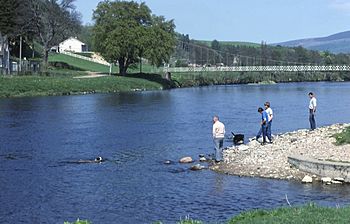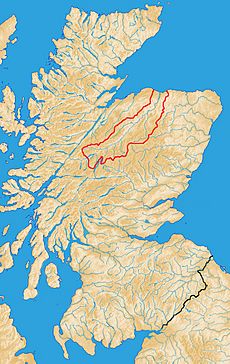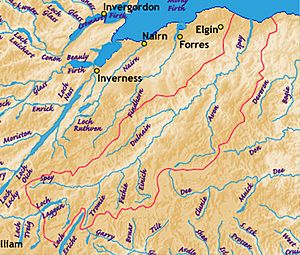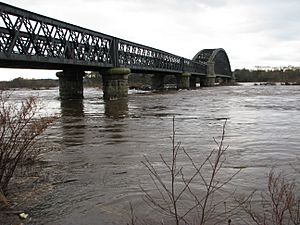River Spey facts for kids
Quick facts for kids River Spey |
|
|---|---|

The River Spey at Aberlour
|
|
| Country | United Kingdom |
| Physical characteristics | |
| Main source | Loch Spey 57°00′26″N 4°36′18″W / 57.00729°N 4.60499°W |
| River mouth | Moray Firth at Spey Bay |
| Length | 107 mi (172 km) |
| Basin features | |
| Basin size | 3,008 km2 (1,161 sq mi) |
| Official name: River Spey - Insh Marshes | |
| Designated: | 2 February 1997 |
| Reference #: | 889 |
The River Spey is a famous river in the northeast of Scotland. It is the ninth longest river in the United Kingdom. It is also the third longest and one of the fastest-flowing rivers in Scotland. The Spey is very important for salmon fishing and making whisky.
Contents
Where the River Spey Starts and Ends
The River Spey is about 107 miles (172 km) long. It begins high up in the Scottish Highlands at Loch Spey. This is about 10 miles (16 km) south of Fort Augustus.
After leaving its source, the river flows through a dam called Spey Dam. It then passes through towns like Newtonmore and Kingussie. The river also crosses Loch Insh before reaching Aviemore. The area around the river is known as Strathspey.
From Aviemore, the Spey flows about 60 miles (97 km) northeast. It finally reaches the sea at the Moray Firth, near Spey Bay. This is about 5 miles (8 km) west of Buckie.
How the River Spey Changes Course
The Spey can change its path quite often. This happens because of natural processes like sediment building up and erosion. Sometimes, the river's path can change very quickly, even in a few hours, during a flood.
The Spey floods quickly because it has a large area of mountains that collect rainwater or melting snow. This water then rushes into the river.
The Insh Marshes are special areas along the Spey. They are about 2 miles (3.2 km) wide on each side of the river. These marshes are protected as a Site of Special Scientific Interest. The large shingle (small stones) areas at Spey Bay are also protected.
Rivers Joining the Spey
Many smaller rivers and streams flow into the River Spey. These are called tributaries.
- The Markie Burn is one of the first streams to join the Spey.
- The River Mashie also flows into the Spey from the south.
- The River Truim joins the Spey near Newtonmore.
- The Highland Calder joins at Newtonmore.
- At Kingussie, the River Gynack flows into the Spey.
- The River Tromie joins about 1.5 miles (2.4 km) downstream.
- The large River Feshie joins at Kincraig.
- The River Druie joins near Aviemore.
- Further downstream, the River Nethy joins near Nethy Bridge.
- The River Dulnain adds a lot of water from the Monadhliath area.
- Between Grantown-on-Spey and Craigellachie, the River Avon is a very important tributary.
- Other streams like the Allt Arder and Knockando Burn also join.
- The River Fiddich joins at Craigellachie.
- The Burn of Rothes joins at Rothes.
- Closer to the sea, the Burn of Mulben, Red Burn, and Burn of Fochabers also flow into the Spey.
Industries and Activities on the Spey
The River Spey has always been important for local businesses. These include salmon fishing and shipbuilding. Long ago, Garmouth was a major shipbuilding center in Britain. Wood from forests near Aviemore and Aberlour was floated down the river to build wooden ships.
Fishing and Spey Casting
The river is famous among anglers (people who fish) for its excellent salmon and trout fishing. A special way of fishing called 'Spey casting' was developed here. This technique uses a long fishing rod and helps anglers cast their line without hitting bushes or trees behind them.
Whisky Production
The Speyside area is known worldwide for its whisky production. More whisky is made here than in any other region of Scotland. The "Scotland's Malt Whisky Trail" is a popular tourist route. It includes seven working Speyside distilleries, a historic distillery, and the Speyside Cooperage (where whisky barrels are made).
This region is perfect for whisky makers for a few reasons:
- It is close to barley farms, which is a key ingredient.
- The River Spey provides clean water.
- It is near the port of Garmouth, which helps with transport.
The Speyside Way
The Speyside Way is a long-distance footpath that follows the river. It is a great way to explore the beautiful scenery of the County of Moray.
River Speed and Changes
The River Spey is unusual because it gets faster as it flows closer to the sea. This makes it one of the fastest-flowing rivers in Scotland, and possibly the UK. Even though it flows fast, the Spey does not usually meander (form winding curves). However, it can quickly change its banks.
South of Fochabers, there is a high earth barrier to protect the banks. But the river has broken through this barrier several times. When it floods, it has damaged parts of the Garmouth Golf Course, walls around Gordon Castle, sections of the Speyside Way, and even some roads.
The Spey railway bridge, which is now used by pedestrians, was built with its main part over the river's main flow. But before it was finished, the river had already changed its course. The main flow ended up at one end of the bridge instead!
Towns and Villages Along the Spey
Starting from where the river begins:
- Laggan
- Newtonmore
- Inverdruie
- Aviemore
- Boat of Garten
- Grantown on Spey
- Cromdale
- Mains of Dalvey
- Advie
- Ballindalloch
- Pitchroy
- Blacksboat
- Marypark
- Knockando
- Carron
- Speyview
- Aberlour
- Craigellachie
- Dandalieth
- Rothes
- Crofts
- Newlands of Dundurcas
- Garbity
- Ordiequish
- Fochabers
- Upper Dallachy
- Stynie
- Garmouth
- Kingston on Spey
- Spey Bay
See also
 In Spanish: Río Spey para niños
In Spanish: Río Spey para niños




